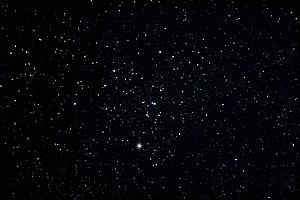Hyades cluster

Photograph of the Hyades Cluster
|
|
| Observation data (J2000.0 epoch) | |
| Constellation | Taurus |
| Right ascension | 4h 27m |
| Declination | +15° 52′ |
| Distance | 153 ly (47 pc) |
| Apparent magnitude (V) | 0.5 |
| Apparent dimensions (V) | 330′ |
| Physical characteristics | |
| Mass | 400 M☉ |
| Radius | 10 light years (core radius) |
| Estimated age | 625 million years |
| Other designations | Melotte 25, Collinder 50, Caldwell 41 |
The Hyades (/ˈhaɪ.ədiːz/; Greek Ὑάδες, also known as Melotte 25 or Collinder 50) is the nearest open cluster and one of the best-studied star clusters. Located about 153 light-years (47 pc) away from the Sun, it consists of a roughly spherical group of hundreds of stars sharing the same age, place of origin, chemical characteristics, and motion through space. From the perspective of observers on Earth, the Hyades Cluster appears in the constellation Taurus, where its brightest stars form a "V" shape along with the still brighter Aldebaran. However, Aldebaran is unrelated to the Hyades, as it is located much closer to Earth and merely happens to lie along the same line of sight.
The five brightest member stars of the Hyades have consumed the hydrogen fuel at their cores and are now evolving into giant stars. Four of these stars, with Bayer designations Gamma, Delta 1, Epsilon, and Theta Tauri, form an asterism that is traditionally identified as the head of Taurus the Bull. The fifth of these stars is Theta1 Tauri, a tight naked-eye companion to the brighter Theta2 Tauri. Epsilon Tauri, known as Ain (the "Bull's Eye"), has a gas giant exoplanet candidate, the first planet to be found in any open cluster.
...
Wikipedia
